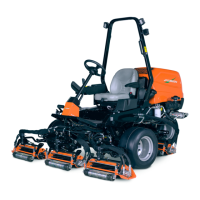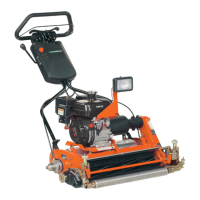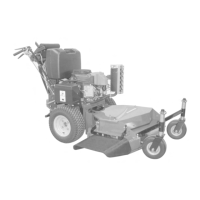STEERING
4181383 First Edition 7-5
7
Steering Relief Valve Pressure Test
See Figures 7-3 and 7-4.
!
WARNING
1. Park the mower safely. (See “Park Mower Safely” on
page 1-5.)
2. Remove seat and mount plate. (See “Seat and Mount
Plate” on page 9-10.)
Figure 7-3
3. Disconnect line (2) from port (1).
4. Install tee fitting to port (1).
5. Connect line (2) to tee fitting.
Figure 7-4
6. Connect test hose from tee fitting to 5000 psi (345
bar) test gauge (3).
7. Disconnect and cap both steering cylinder hydraulic
hoses.
8. Operate hydraulic system until oil temperature is at
120-—150°F (49—65°C).
NOTICE
9. Start engine and run at full throttle (2850 ± 50 rpm).
10. Turn steering wheel fully right against stop.
11. Record pressure reading.
Is lift/steer system relief pressure 1740 psi (120
bar)?
YES Lift/steer system relief valve is good.
Proceed to step 14.
NO Proceed to next step.
12. Raise the decks and hold the joystick in the raise
position.
13. Record pressure reading.
Is lift/steer system relief pressure 1740 psi (120
bar) reached?
YES Relief valve is good. Replace steering valve.
(See “Steering Valve” on page 7-7.)
NO Relief valve is faulty. Repair or replace relief
valve.
14. Stop engine.
15. Disconnect and remove test equipment. Install all
hoses and fittings as noted prior to removal.
16. Check hydraulic oil level. Add oil as needed. (Refer to
“Safety, Operation, and Maintenance Manual” for
correct oil specifications.)
• The hydraulic system is under pressure, and
the oil will be hot.
• Always relieve pressure in the hydraulic
system before performing service.
• Failure to follow appropriate safety
precautions may result in death or serious
injury.
Required Tools and Materials
• Pressure Gauge 0—5000 psi (0—345 bar)
•Test Hose
• Tee Fitting
T
N
1
4
1
7
2
1
Do not run mower lift/steer system relief valve
over relief longer than 10 seconds or damage to
hydraulic system may occur.
T
N
1
2
7
5
3

